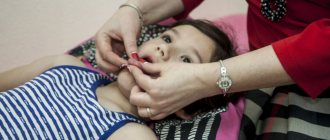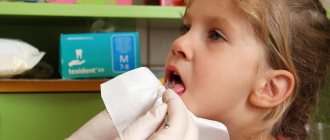Hypertonicity in a child is an excessive overstrain of the flexor muscles. It is due to the fact that for a long time the muscles of an unborn child are in constant tension: in the uterine cavity, the arms are clenched into fists, and the legs are pressed to the body, and the chin is to the chest. In the womb, fetal movements are limited and not varied. It is more comfortable for newborns to maintain the fetal position, this way they feel more protected and calm.
The tension in the muscles of the baby's head and neck in the mother's belly is quite strong, so after birth the head is slightly tilted back, and the limbs are bent and pressed close to the body. In nine cases out of ten, children in the first months of life experience muscle tone, which goes away on its own. As the child grows and adapts to living conditions outside the womb, the muscles relax and voluntary movements appear. However, in some infants the state of tone persists even after 3 months, which may indicate deviations from the norm and the need for treatment. Most often this is due to the fact that during intrauterine development or during childbirth (immediately after it) the child’s nervous system was damaged. The central nervous system is not able to fully transmit impulses to the muscles for their proper functioning due to damage to the neurons of the brain.
Do not be afraid of this diagnosis, since the child’s nervous system is not fully formed, and its condition can be influenced. The main thing is to pay attention to the baby’s well-being and behavior in time, consider the deviation and seek help from a specialist.
Doctors distinguish the following types of hypertension:
- general, that is, the whole organism;
- only upper or lower extremities;
- according to hemitype, that is, the tone of the limbs on one side: right or left.
How to recognize hypertension in newborns
It is important to monitor the child’s behavior and state of health in order to identify deviations and solve the problem in a timely manner. Parents should monitor their baby and consult a doctor if the following symptoms occur:
- from the first days a newborn holds his head, and does not “drop” it back;
- When you move your arms or legs to the sides, you feel resistance. When trying again, the child becomes unhappy, cries, and the tension increases;
- frequent, profuse regurgitation after feedings with general poor appetite, colic;
- restless and short sleep, in which a tense posture remains: arms and legs are pressed tightly to the body, the head is pulled back, nervous twitching is possible;
- throwing back the head and arching the body, tremor of the chin and limbs when crying;
- increased excitability of the child, painful reaction even to minor sound and light stimuli;
- Taking the child by the arms and placing him on a flat surface, slightly tilting him forward, you can observe that he will reflexively begin to walk. In this case, the baby puts his foot on his full foot, and does not walk on tiptoe.
Lip muscle massage
Relaxing massage.
- Using the palmar surface of the index fingers, make stroking movements along the upper lip from the corners of the mouth to the middle.
- The same movements are made along the lower lip from the corners of the mouth to the middle.
- The movement is performed with the pads of the index and middle fingers alternately with the right and left hands. The movement begins from the tragus of the auricle, the fingers easily slide along the cheek and then around the lips. In this case, the index finger slides over the skin of the upper lip, and the middle finger over the skin of the lower lip, coming together at the opposite corner of the mouth.
- Using the pads of the index and middle fingers, stroke the nasolabial folds, moving from the wings of the nose to the corners of the mouth.
- With the same fingers, lightly tap around the lips in a clockwise direction. Massage movements can be carried out with the mouth in different positions: closed and slightly open.
Invigorating massage . Rubbing techniques are used in the form of semicircular and spiral movements, kneading in the form of rubbing and vibration.
- The palmar surface of the index fingers makes movements along the upper lip from the middle to the corners of the mouth. The same movements are used on the lower lip.
- With the thumbs of both hands, make movements from the middle of the upper lip to the corners of the mouth and slightly down, and then with the index fingers - from the middle of the lower lip to the corners of the mouth and slightly up. The movements alternate.
- Stroke the nasolabial folds, moving from the corners of the lips to the wings of the nose.
- Using your thumb and forefinger, grab your upper lip into a vertical fold, squeeze it and rub it between your fingers. The capture is carried out in the central part of the lip.
- Use your thumb and forefinger to grab the skin around your lips and perform a pinching technique.
- The ends of the index and middle fingers are tapped intensively around the lips.
- Rubbing movements carried out by the thumb and forefinger in the direction from one corner of the mouth to the other along the upper and then lower lip.
- Spiral movements made with the thumb and forefinger along the upper and then lower lip.
- Spiral kneading of the nasolabial fold area. The phalanx of the thumb is located in the oral cavity under the nasolabial fold, the index and middle fingers are located on top.
- Point squeezing of the lip between the thumb and index finger. Localization of points.
- The speech therapist places his index fingers on a point located between the middle of the upper lip and the corner of the mouth on both sides. A movement is made towards the middle so that the upper lip is gathered into a vertical fold. A similar movement is carried out on the lower lip.
- The specialist places the index and middle fingers near the corners of the mouth and slightly stretches the lips, as if smiling; with a reverse movement, the lips return to their original position. Movements are light and smooth. These exercises can be performed with the mouth closed or open.
Why does hypertension occur in infants?
The causes of hypertension in infants are caused by the action of unfavorable factors during intrauterine development, during childbirth, or in the first days after birth.
During pregnancy, the fetus may suffer due to the following factors:
- hypoxia - a long period of oxygen starvation;
- acute infectious diseases suffered by the mother or her chronic diseases;
- general intoxication of the mother’s body;
- bad habits of women: smoking, drinking alcohol, taking drugs;
- early/late toxicosis, threat of miscarriage, uterine tone;
- Rh conflict between mother and child.
Difficult, rapid or, conversely, protracted labor can also cause increased muscle tone in babies. Various birth injuries, umbilical cord entanglements, lack of oxygen (hypoxia) - all this can lead to disruption of the newborn’s nervous system and cause abnormalities and illness.
Types, levels and forms of speech dysarthria in children
Table of types of disease by location of the lesion
| Name of the pathology form | Peculiarities |
| Cerebellar | Occurs when the cerebellum is involved in the process. Speech is drawn out, slurred, slow, the volume constantly changes, the child’s tongue trembles, he speaks with shouts, as if chanting slogans. Additional symptoms: poor balance, unsteady gait. |
| Bulbarnaya | It is caused by paralysis of the articulatory muscles, as well as the nerves - vagus, glossopharyngeal, ternary, sublingual and/or others. Children lack some reflexes, sucking and swallowing, facial expressions are impaired, and it is difficult for them to chew solid food. There is also increased salivation, simplification (all consonants “merge” into one fricative) and slurred sounds, a nasal, hoarse sound of the voice, sometimes its absence. |
| Pseudobulbar | Occurs with centralized paralysis (spastic) of muscles and their hypertonicity. Speech becomes monotonous, it is difficult for the child to lift the tip of the tongue, move it to the side, or hold it. There is increased salivation, soreness, and swallowing disorders (increased reflex). Speech is slurred, nasal, the pronunciation of hissing, whistling and tone sounds is sharply impaired. |
| Extrapyramidal | It occurs when the function of the subcortical nuclei is disrupted, and therefore received a second name – “subcortical”. Speech is slightly nasal, slurred, and slurred. There are involuntary muscle movements, facial expressions, and articulatory spasms. The timbre and strength of the voice changes, the pace of conversation is disrupted, and there are occasional guttural cries. |
| Cortical | Damage to those areas of the cerebral cortex that are responsible for articulatory muscles. Children pronounce words correctly in structure, but with impaired pronunciation of syllables. There is difficulty breathing during conversation and voice. |
| Cold | Manifests itself as one of the symptoms of myasthenia gravis (fatigue and weakness of striated muscles). Speech disruptions occur when the air temperature in the room where the child is located increases or decreases. |
Classification according to the degree of development of pathology:
- I (erased) - only a speech therapist can identify incorrect pronunciation during examination and examination, almost complete recovery is possible;
- II – pronunciation is clear, but defects are noticeable;
- III – the child is understood only by close people, strangers rarely;
- IV – even relatives do not understand the pronunciation or there is no speech, most often considered within the framework of cerebral palsy.
Important! The erased form is characterized by difficulty chewing solid food. Parents should not change their child's diet because of this. It is necessary to gradually accustom him to chew on the same basis as other people. Source: E.F. Arkhipova Erased dysarthria in children: a textbook for university students // M.: AST: Astrel: KHRANITEL, 2006, p.319
How to treat hypertension in infants
Hypertonicity in infants is very common. When examining a child, a pediatrician and neurologist can easily identify it. In some cases, the increased tone goes away on its own by 3–4 months. In addition to the main symptoms, doctors rely on the following reflexes of the child, which, with normal development, should disappear by the 3rd month of life:
- step reflex. With the body in a vertical position, the baby begins walking movements on a flat surface;
- support reflex. On the floor, the child places his foot on the entire foot, and not on the toe;
- symmetry/asymmetry reflex. When the baby lies on his back and presses his chin to his chest, his legs extend and his arms bend. When tilting the head to the left, the left limbs bend; when tilting to the right, vice versa;
- tonic reflex. In the position on the stomach, the arms and legs are bent; in the position on the back, they are straightened.
In addition to pediatrics and neuropathology, osteopathy is widely popular and effective in treating tone in children. This is the main alternative to traditional treatment: massages, physiotherapy, aromatherapy, therapeutic exercises, drug treatment, which in most cases only relieves symptoms. The main task of the osteopath in this case is to find the cause of abnormalities in infants and eliminate hypertonicity.
The doctor collects a detailed medical history and asks how the pregnancy and childbirth proceeded. For osteopathy, the human body is a single whole, all its organs and systems are inextricably linked with each other. The specialist has very sensitive fingers, and all the manipulations he performs are extremely soft and gentle.
Disorders of the nervous system, which causes muscle tone in infants, are treated by an osteopath with a special massage. These procedures do not cause pain or discomfort in children, therefore they are absolutely safe. The positive effect will be noticeable after the first sessions. The child experiences an improvement not only in muscle tone, but also in appetite, sleep, and digestive processes. The osteopathic doctor triggers the necessary mechanisms in the baby’s body, aimed at correcting the functioning of the brain centers and metabolic processes between them.
Parents should listen to the doctor’s recommendations, but self-medication is unacceptable, since the osteopathic doctor performs extremely delicate and gentle manipulations with the child, requiring certain knowledge, skills and qualifications. The duration of therapy is different for each patient, so return visits to the clinic may be repeated after one to two weeks.
Treatment of tongue spasms
But how can all this help people suffering from tongue spasms? Since dystonia greatly affects the lives of patients, many researchers are busy developing various methods of treating it. The most conservative approach is offered by speech therapy. Repeated exercises strengthen the tongue muscles, and the patient learns to properly tense and relax them when speaking and swallowing food, experts explain.
A more radical method is Botox injections. Botulinum toxin temporarily paralyzes the facial muscles, preventing spasms, but such injections must be done every two to three months when the effect of the drug wears off. Despite a number of disadvantages, this method of treating dystonia is the most effective today, clinicians note.
Treatment of dystonia involves the participation of a whole group of doctors from various specialties. The approach to treatment will depend on the nature of the symptoms that bother you, as well as on your desire to use the treatment method suggested by your doctor. Tongue spasms can cause a lot of trouble, but once the correct diagnosis is made and the appropriate treatment is chosen, patients can expect to return to normal life.
Why is hypertension dangerous?
As mentioned earlier, infant hypertonicity can be caused by disorders of the nervous system. It is obvious that such deviations will worsen and develop if measures are not taken. At first, motor disturbances in the baby will be noticeable, and subsequently deviations in fine and gross motor skills, coordination, and speech will appear. Possible problems with gait and posture, developmental delay. All of the above suggests that the problem of increased tone in infants requires special control, primarily from parents. Timely detection of disorders, their causes, as well as subsequent proper treatment is the key to the health and normal development of a little person.
Contraindications
Speech therapy massage for children with dysarthria cannot be performed when the child has:
- rash, swelling of various types on the skin;
- exacerbation of herpes infection;
- colds, viral diseases;
- inflammatory processes of the oral cavity and lips - stomatitis, gingivitis, caries, fungal infection;
- inflammatory processes of nearby organs - conjunctivitis, rhinitis, lymphadenitis, furunculosis;
- cuts, abrasions, hematomas;
- severe chronic diseases - oncological, cardiovascular, hematological, neurological, psychiatric.









